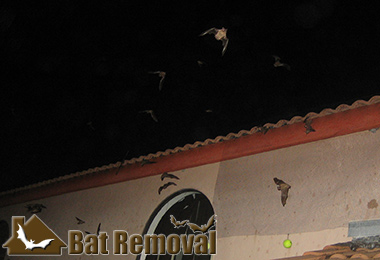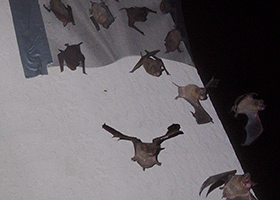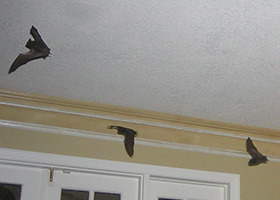Albany Bat Removal
Welcome to Albany Bat Removal! We are New York bat removal specialists. It is important to know that bats are protected by New York law, and are beneficial animals to have in the environment. We do not kill any bats during our bat removal process. Never hire a pest control company or anyone who says they are a Albany bat exterminator. For correct and effective bat removal, you want a company that specializes in humane bat colony extraction. Our process is not only the only legal method in New York, but it is the most effective. We have a 100% success rate in our bat control process. We perform our industry-best 32-point inspection of your house or building, and seal shut all bat entry holes down to 1/4 inch as part of the removal process, during which we remove the colony via special one-way exclusion devices specific to your architecture. Once all bats are safely out, we permanenetly bat-proof the structure. We also provide guano (bat droppings) removal and decon. Click on our Albany Bat Control Prices page to find out more about our prices for bat control work. We work 24/7/365, and would love to talk to you about your bat problem. Call us any time at 518-300-4992 to discuss it, discuss our pricing, and if you wish, set up an appointment at your convenience, often same-day.

Albany Building and Attic Inspections

No-kill New York Bat Extraction

Guano Cleanouts - Serving all of New York
Call 24/7 to discuss your bat problem.
Same-day or next-day appointments.
32-point inspection of your property.
Written estimates for bat removal project.
Fully state licensed and insured.
Residential and commercial service
100% no-kill Albany bat extraction
Complete bat-proofing of your building
Compliance with all New York, federal laws
Guano removal and attic decontamination
Our Service Range - 518-300-4992



A Comprehensive Guide on Bat Migration
For many years, we already know that some bats will go through a seasonal migration. Our understanding towards the bat migration has become more profound during the recent years. This is thanks to the experts who have worked hard to compile different information related with their migration. There has also been an increasing interest towards this subject due to its direct impact on our ecosystem.
Why Do Bats Migrate?
In order to comprehend the reason behind this behavior of the bats, you will need to know the evolutionary and ecological elements that lead to migration. You should also observe the migratory bats and determine the characteristics that they will commonly have.
Bats in The Temperate Zone
The bats that live in the temperate regions will migrate to avoid the unfavorable weather condition. Most of the bats in the colder regions will go through a state of hibernation to escape the unforgiving weather. In these areas, the migration among bats will be uncommon. For species of bats that roost on trees, hibernation may not be sufficient to survive the harsh climate. This is since the trees will not provide them a high level of protection against predators and cold. Therefore, these bats will travel hundreds and sometimes thousands of miles to enjoy a more favorable climate. The seasonal migration of these bats is also referred to as regional migration.
Bats in the Tropical Zones
Bats in the tropical or the subtropical areas may also be forced to move. However, the reason behind their migration will not be due to the weather. Usually, the reason would be the availability of the food. The geographical distribution of their food will change depending on the season. Flying foxes are species of bats that will have this behavior. Their movement will correspond to the fluctuation of the food. Other research also suggests that bats can also migrate to find a potential mate.
Genetic Factor
There are also some questions if the migratory behavior of the bats can be traced to their genes. On migratory birds, their behavior can be traced back to their intricate genetic design. Since most of the families of bats have originated from the tropical regions where there is a lack in migratory behavior. This has led to the belief that their ancestors are mostly sedentary. Nonetheless, the migratory behavior is still present in some genera of bats. Around 15 species of bats will migrate on long distance.
The migration of the bat is a complex behavior. The current knowledge of the human towards their behavior is limited that warrants for additional studies. More information will need to be gathered toward the energy required to migrate, point of their departure, and the timing related with their migration. There is also not enough data about the landmark and the route that they need to follow. It has only been recently since more scientists have studied the way that these creatures navigate while they are in the process of migration.

